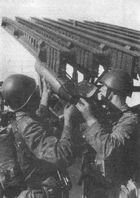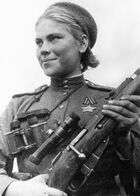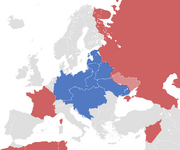Conduct of operations
Autumn and Winter 1939–40

"Katyusha" – a notable Soviet rocket launcher
Following several Soviet-staged incidents (like the Rostov-on-Don incident), which Soviet propaganda used as a pretext to claim that Soviet forces were acting in self-defence, the first regular act of war took place on 26 August 1939 at 04:40, when the Soviets blasted through Ukrainian positions and headed for Kharkiv. They were soon outflanked on another line to the west as the Soviets advanced down the Psel, and Kharkiv had to be evacuated becoming the first city to fall to the Red Army. This invasion subsequently began European War. The governments of Germany and Austria declared war on the Soviet Union on 28 August; however, they failed to provide any meaningful support. The Austrian and German air forces began mobilising and moving into Ukrainian airspace. Austrian ground forces began moving into western Ukraine to provide support and hold the front line if they were defeated. On 31 August Belarus declared war on the Soviet Union after allowing a number of German forces into their country for support.
The Ukrainian forces on the Mius, comprising the 6th Sich Division and 20th Pavlohrad Cavalry Regiment, were too weak to repulse a Soviet attack on their own front, and when the Soviets hit them they had to fall back all the way through the Donbass industrial region to the Dnieper, losing vital industrial resources and half of the nations farmland. The Hetman of Ukraine, Vasyl Vyshyvanyi, agreed to a general withdrawal to the Dnieper line, along which was meant to be a line of defence similar to the Siegfried Line of fortifications along the German frontier in the west. The main problem for the Ukrainians was that these defences had not yet been built; by the time the Ukrainian Army had evacuated eastern Ukraine and begun withdrawing across the Dnieper during September, the Soviets were hard behind them. Tenaciously, small units paddled their way across the 3 km (1.9 mi) wide river and established bridgeheads. As September ended and October started, the Ukrainians found the Dnieper line impossible to hold as the Soviet bridgeheads grew, and important Dnieper towns started to fall, with Zaporozhye the first to go, followed by Ekaterinoslav. Finally, early in November the Soviets broke out of their bridgeheads on either side of Kiev and captured the Ukrainian capital.

Soviet sniper Roza Shanina in 1944. About 400,000 Soviet women served in front-line duty units
Eighty miles west of Kiev, the Austrian 4th Galician Army, convinced that the Red Army was a spent force, was able to mount a successful riposte at Zhytomyr during the middle of November, weakening the Soviet bridgehead by a daring outflanking strike mounted by the Ukrainian 93rd Armor Battalion along the river Teterev. This battle also enabled the Ukrainian Army to recapture Korosten and gain some time to rest; however, on Christmas Eve the retreat began anew when the Ukrainian Front struck them in the same place. The Soviet advance continued along the railway line until the 1939 Austrian–Soviet border was reached on 3 January 1940. To the south, the Soviets had crossed the Dnieper at Kremenchuk and continued westwards. In the second week of January 1940 they swung north, meeting Vatutin's tank forces which had swung south from their penetration into Belarus and surrounding ten Austrian divisions at Korsun–Shevchenkovsky, west of Cherkassy. Emperor Otto's insistence on holding the Dnieper line, even when facing the prospect of catastrophic defeat, was compounded by his conviction that the Cherkassy pocket could break out and even advance to Kiev, but Raus was more concerned about being able to advance to the edge of the pocket and then implore the surrounded forces to break out. By 16 February the first stage was complete, with tanks separated from the contracting Cherkassy pocket only by the swollen Gniloy Tikich river. Under shellfire and pursued by Soviet tanks, the surrounded Austrian troops fought their way across the river to safety, although at the cost of half their number and all their equipment. They assumed the Soviets would not attack again, with the spring approaching, but on 3 March the Soviet Ukrainian Front went over to the offensive. Having already secured the Crimea by severing the Perekop isthmus, Sovetnikov's forces advanced across the mud to the Romanian border, not stopping on the river Prut.

Soviet advances from 24 August to 31 December 1939.
One final move in the south completed the 1939–40 campaigning season, which had wrapped up a Soviet advance of over 500 miles. In March, 20 German divisions of General der Infanterie István Náday's 1st Hungarian Army were encircled in what was to be known as Náday's Pocket near Kamenets-Podolskiy. After two weeks' of heavy fighting, the 1st Hungarian managed to escape the pocket, suffering only light to moderate casualties. In April, the Red Army took Odessa.
Along Belarus' front, August 1939 saw this force pushed back from the Hagen line slowly, ceding comparatively little territory, but the loss of Bryansk, and more importantly Smolensk, on 25 September cost the Belarusian National Army the keystone of the entire defensive system. The 4th and 9th armies and German 3rd Panzer Army still held their own east of the upper Dnieper, stifling Soviet attempts to reach Vitebsk. In the Baltic region, there was barely any fighting at all until January 1940, when out of nowhere Volkhov and Second Baltic Fronts struck. To Stalin, the Baltic Sea seemed the quickest way to take the battles to the German territory in East Prussia and seize control of Finland. The Red Army's offensives towards Tallinn, a main Baltic port, were stopped in February 1940. The Livonian units included Estonian conscripts, fighting to prevent returning to Russian control.